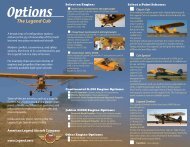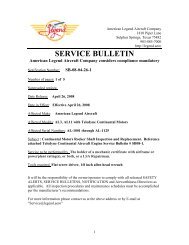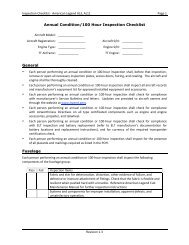Lycoming Flyer - Aircrafts sales, engines repair, spare parts
Lycoming Flyer - Aircrafts sales, engines repair, spare parts
Lycoming Flyer - Aircrafts sales, engines repair, spare parts
- No tags were found...
Create successful ePaper yourself
Turn your PDF publications into a flip-book with our unique Google optimized e-Paper software.
engine, and break down the sample in <strong>parts</strong> per million in orderto determine the internal health of the engine. This is based onthe fact that all lubricated engine <strong>parts</strong> wear and deposit a certainamount of metallic particles in the oil. The number of particlesper million of each metal determines the wear pattern for theparticular engine being analyzed. It is of the utmost importanceto understand that the result of the analysis is only pertinent tothe engine being analyzed, although accumulation of data onany specific engine series is a basis for establishing standards forthat series of engine.The fact that is important is a sharp rise above normal of theamount of a particular metal in the oil. It is imperative then tobuild a case history of each engine, wherein a sharp rise in anyone metal will indicate abnormal engine wear. The analysis canalso tell you whether the oil contains other liquid contaminantssuch as gasoline or water. Gasoline contamination of the oil canresult from blow-by from the combustion chamber caused by poorcombustion, bad timing, improper fuel mixture, worn rings andthe like. Water contamination is usually restricted to condensedvapor, but this vapor combines with the fuel combustion productsto form harmful metal-attacking acids. Based on this contaminationin the oil, the analysis will be able to pinpoint impropermixture, poor maintenance, etc.<strong>Lycoming</strong> Service Letter No. L171, entitled “General Aspects ofSpectrometric Oil Analysis,” provides a guide for the use of oil analysisin measuring engine health. The information is in general terms since thehealth of each engine must be determined on its own merits.Differences in manufacturing processes may cause a variationin analysis results for different engine models. The amount oftin plating, copper plating, nitriding, etc., performed duringmanufacture has a definite relationship to the oil analysisreports. It is not uncommon, for example, to see what seemsto be high copper content early in the life of an engine, onlyto have this content continually decrease as the engine accumulatestime, and then disappear altogether. Poor air filtermaintenance, running the aircraft on the ground with carburetor/alternate air on, and holes in the air intake system are allfactors which will allow an engine to ingest dirt and foreignmatter. The result of this will show up as high iron (cylinder barrels)and chrome (piston rings) content at the next oil analysis.Neither time nor space permits us here to list all of the variablesinvolved (indeed we do not profess to know them all) but it shouldbe obvious to everyone that a continuing history of each engine isthe only criteria by which its health can be determined.Remember that several samples taken at the regular oil changeintervals must be analyzed to determine the normal characteristicsof an engine, and also remember that the first few samples onfactory fresh <strong>engines</strong> will read high as new <strong>parts</strong> are wearing inand conforming to each other.Excessively heavy wear of internal engine <strong>parts</strong> will show up astraces in <strong>parts</strong> per million during analysis long before detrimentalflaking or scoring takes place, and almost always before anyoutward indication of trouble. This initial departure from normalis not usually any reason to tear the engine down. An investigationand timely and appropriate corrective action (replacing theair filter, perhaps) by the operator will usually result in traceelements returning to normal at the next oil change. If longTBOs are to be achieved, it is most important that clean air beprovided to the <strong>engines</strong>.Basically and briefly, that is the oil analysis story. It is a goodtool if properly used. Like any other tool, it is only one of manythings that must be used to determine engine health.A <strong>Flyer</strong> reader wrote to express interest in a <strong>Lycoming</strong> IO-360engine. He went on to say that the engine would be used in anaircraft capable or unlimited aerobatics. A statement like thisindicates a need for explanation of the differences between thestandard <strong>Lycoming</strong> engine and the aerobatic <strong>Lycoming</strong> engine.Aerobatic flight with a non-aerobatic engine could result inengine stoppage from either fuel or oil starvation.It should first be explained that unlimited aerobatic flightimplies that the aircraft may be flown in any altitude with nolimitations. Although an aircraft may have excellent aerobaticcapability, every aircraft and engine does have limitations whichmust not be exceeded.Any engine which employs a float-type carburetor for fuelmetering is immediately eliminated from use in a fully aerobaticaircraft. Inverted flight for more than a few seconds wouldcause the carburetor to stop metering fuel and the engine to stoprunning. While carbureted <strong>engines</strong> are used in some aircraft withlimited aerobatic capability, only positive G maneuvers and verybrief periods of inverted flight are possible.To operate correctly, an engine must have fuel which is properlymetered in proportion to the air entering the engine inductionsystem. The fuel injector measures air flow and meters fuel tothe inlet ports of each cylinder. Unlike the carburetor, a fuelinjector is not affected by unusual aircraft attitudes. Therefore,all <strong>Lycoming</strong> <strong>engines</strong> that are designed for aerobatic flight areequipped with a fuel injector.Delivery of metered fuel to the combustion chamber is not theonly challenge addressed in designing an aerobatic aircraftengine. It is also necessary to provide lubricating oil to manypoints in an operating engine regardless of the aircraft attitude.Two different methods have been used to provide oil for aerobatic<strong>engines</strong> manufactured by <strong>Lycoming</strong>.The flat, opposed cylinder aerobatic <strong>engines</strong> first offered by<strong>Lycoming</strong> were designated AIO-320 or AIO-360. These <strong>engines</strong>were the dry sump type with appropriate oil inlet and outlet connectionsas well as two crankcase breather connections. Necessarylines and an external oil tank with a revolving pickup capable ofreaching oil in almost any aircraft attitude were then supplied by theaircraft manufacturer. This type of installation provided aerobaticcapability, but it was complicated enough to be very expensive. Asimpler, more universally usable system was needed.Most <strong>Lycoming</strong> <strong>engines</strong> are termed “wet sump” <strong>engines</strong> becauseoil is stored internally in a sump at the bottom of the crankcase.When the engine is inverted, the oil will be in the top of the crank-1 4 L y c o m i n g F l y e r









